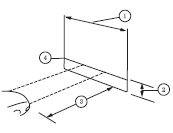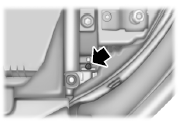Adjusting the headlamps
The headlamps on your vehicle are properly aimed at the assembly plant.
If your vehicle has been in an accident, the alignment of your headlamps should be checked by your authorized dealer.
Vertical Aim Adjustment
The headlamps on your vehicle can only be vertically adjusted. Your vehicle does not require horizontal aim adjustments.
To adjust the headlamps:
1. Park your vehicle on a level surface about 25 feet (7.6 meters) away from a vertical plain surface (3). Check your headlamp alignment at night or in a dark area so that you can see the headlamp beam pattern.

• (1) 8 feet (2.4 meters)
• (2) Center height of lamp to ground
• (3) 25 feet (7.6 meters)
• (4) Horizontal reference line
2. The center of the headlamp has a 3.0 millimeter circle on the lens.
Measure the height from the center of your headlamp to the ground (2) and mark
an 8 foot (2.4 meter) long horizontal line on the plain surface (1) at this height
(masking tape works well).
3. Turn on the low beam headlamps to illuminate the wall or screen and open the
hood. To see a clearer light pattern for adjusting, block the light from one headlamp
while adjusting the other.
For vehicles with halogen headlamps:

On the wall or screen you will observe a flat zone of high intensity light located at the top of the right hand portion of the beam pattern.
If the top edge of the high intensity light zone is not at the horizontal reference line, the headlamp will need to be adjusted.
For vehicles with HID headlamps:

There is a distinct cut-off (change from light to dark) in the left portion of the beam pattern.
The top edge of this cut-off should be positioned two inches (50.8 millimeters) below the horizontal reference line.
4. Open the hood.

5. Locate the vertical adjuster for each headlamp. Using a Phillips #2 screwdriver, turn the adjuster control either clockwise or counterclockwise in order to adjust the vertical aim of the headlamp.
Note: HORIZONTAL AIMING IS NOT REQUIRED FOR THIS VEHICLE AND IS NON-ADJUSTABLE.
See also:
Engine oil check
Note: Check the level before starting the engine.
Note: Make sure that the level is between the MIN and MAX marks.
1. Make sure that your vehicle is on level ground.
2. Turn the engine off and wait ...
Turn signal control
• Push down to activate the left turn signal.
• Push up to activate the right turn signal.
...
Airbag disposal
Contact your authorized dealer as soon as possible. Airbags MUST BE disposed
of by qualified personnel. ...
